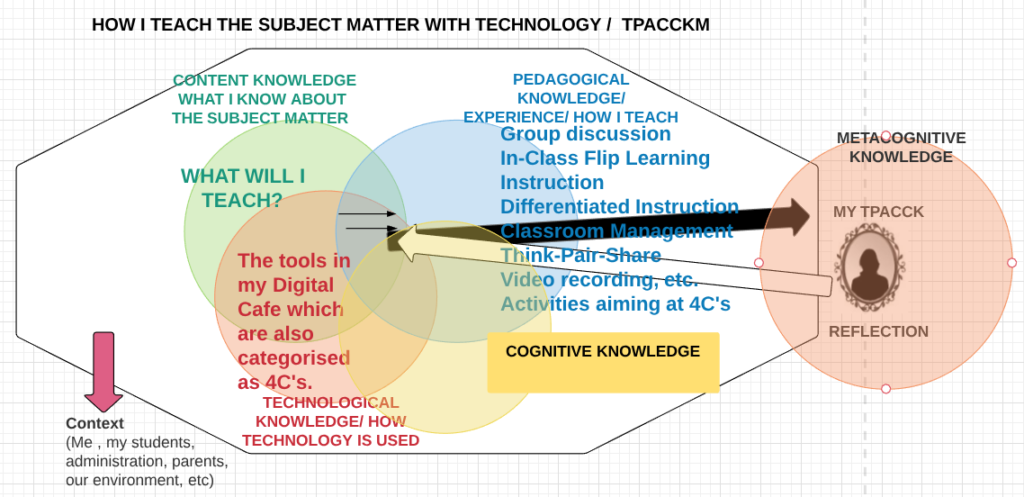MY TPACK CAFE

TPACK is a framework that combines 3 knowledge areas that teachers use. These are technology, pedagogy and content knowledge. This framework builds on Shulman’s ( 1986 ) “pedagogical content knowledge” model. Then Mishra and Koehler ( 2006 ) add technology knowledge into this framework.
After seeing Kate Jones’ (2018) TPACCK model, I wanted to add Cognitive and Metacognitive Knowledge into my own TPACK. Then it becomes my own TPACCKM. Here is Kate’s.

My own TPACCKM has
Content knowledge, (all the theories, facts and concepts of my subject area, ELT) answers the question of “what will I teach?”.
Cognitive Knowledge-How I understand the World. Cognitive abilities are brain-based skills to help us do anything from the simplest to the complex. They are related to the mechanisms of how we learn, remember, solve problems and pay attention rather than our actual knowledge. (Michelon: 2006).
Pedagogical Knowledge which is a second kind of Content Knowledge, (Effective teaching strategies, activities including assessment). My Pedagogical Knowledge includes the “how” of teaching in general. It consists of my classroom management strategies, course planning, and student assessment, my in-flip model etc.
Technological knowledge. (the role of technology in order to help students learn the language effectively) It is an additional component for 21st century teaching. It refers to my knowledge about traditional and new technologies integrated into curriculum.
Metacognitive Knowledge, as in Mahdevi and Jaferzade’s article (2014), is one’s knowledge about their own thinking resulting in better learning and understanding (Flavell:1976). When the teacher has a pre-plan, all the time she monitors her and become aware of her action step by step. During that process, she has some evaluation, self- correctness and hase new strategies to overcome the issue for the next lesson (Erbaum et.al. : 2015).
As John Dewey, an American Philosopher, psychologist, and educational performer says ‘We do not learn from experience… we learn from reflecting on experience’. Accordingly, with my metacognitive knowledge, I can monitor, evaluate and use remedial strategies for better teaching.

Please bear in mind that we are living in the 21th Century and in this century, the capacity for human interaction has changed so enormously through developments in communication technology. Today’s students are no longer the students our educational system has designed to teach.
Part of my context, my students, prefer to do everything online. With so much variety in their lives, they can easily get bored. Due to this, I need to update my TPACCKM and focus on 21st century core skills to transfer my knowledge into classroom practices.
To do this, I decided to set up my digital TPACCKM Cafe to share my apps with you. I would like to introduce some of them.


- HYPERDOCS are digital documents with hyperlinks. They can be teachers’ digital leeson plans easy to be shared with the students. Teachers can transform learning with hyperdocs into their classes. With them, teachers can offer choices to students to do in class in order to promote differentiated learning.
You can reach the template from https://docs.google.com/document/d/1ebfQUMGlD-QemVU58PQ-C_a6rXKpJ9AhhhIuKjhORHo/edit and you can also get some more ideas from the youtube video: https://www.youtube.com/watch?v=JZmkjQc2wuE. With the Google classrom I can easily share my digital lesson plan which has lots of online materials inside. This also supports paperless learning. It is also easy to share and adapt to teacher’s own classroom.
- ANVILL is a web-based media-rich application. It has an interactive video editor so I can easily embed questions into videos which I have assigned to the groups as different tasks. After creating the tasks, I can easily add your students to the application and let them do their tasks in class online. I can also prepare quizzes with video tasks.
- GO FORMATIVE is an assessment tool where students can type, draw, or submit images to demonstrate their understanding. You can get some more information with https://www.youtube.com/watch?v=keB7CkAgT5E . Personally, I have used this tool as a lesson plan with continuous assessment inside.
- TINY CARDS is a flashcards application to help students study mainly vocabulary. After preparing the decks which have words for the topic, I have asked my students to appload the app and use it just before the lesson finishes. As an explicit way of teaching, it helps a lot to revise the new words. The link can help you how to use the app: https://www.youtube.com/watch?v=PcLzTwLRKT0 .
- POWTOONS help me create my animation presentation. With POWTOONS, I can easily introduce the topic to my students to engage them into the subject. The link will help you to use the POWTOON:https://www.youtube.com/watch?v=AFv8L0z-72c .
- BOCLIPS is a website that you can reach teacher made videos to use in class. If you decide to use in-class flip learning, these videos may help you make a fresh start.
- INSERT LEARNING is one of the extensions of Chrome. It helps me turn the websites into interactive ones. I can insert questions, comments and so on directly into the website and can share it with my students via Google classroom as it is compatible with it. You can download it from the Chrome Web Store. If you want to get some details, you can go to https://insertlearning.com/ .
These are some of the apps I love using with my students. Now it is your turn!
Think of your own TPACK or TPACCKM! What does it look like? What are your weaknesses and strengths for innovative teaching and learning of the 21st Century? Do you think the apps I have shared with you will help you reach your students?
References:
- Michelon, P. (2006) What are Cognitive Abilities and Skills, and How to Boost Them?. Retrieved on December 18, 2006.
- Mahdavi, M. (2014)Teachers’ Metacognitive Knowledge and Teacher Education Programs in Iran as an Input-poor Environment: Training Teachers’ Brains? Retrieved on May 17, 2014.
https://www.textroad.com/pdf/JAEBS/J.%20Appl.%20Environ.%20Biol.%20Sci.%204(7)218-225%202014.pdf
- Flavell, J. H. (1976). Metacognitive aspects of problem solving.In L. B. Resnick (Ed.), the nature of intelligence (pp. 231–235).
- Hillsdale, NJ: Erlbaum. 6. Griffith, P. L., &Ruan, J. (2005). What is metacognition and what should be its role in literacy instruction? In S. Isreal, C. Block, K. Bauserman, and K. Kinnucan-Welsch (Eds.), Metacognition in literacy learning: theory, assessment, instruction, and professional development (pp. 3–18). Mahwah: Lawrence Erlbaum Associates. 7. Leat, D. and Lin,
- Shulman, L. S. (1986). “Those who understand: Knowledge growth in teaching.” Educational Researcher Feb. 1986: 4-14. (AERA Presidential Address). https://www.wcu.edu/WebFiles/PDFs/Shulman.pdf
- Mishra, P., & Koehler, M. J. (2013). “Technological Pedagogical Content Knowledge.” https://www.punyamishra.com/wp-content/uploads/2013/08/TPACK-handbookchapter-2013.pdf )
Links:
